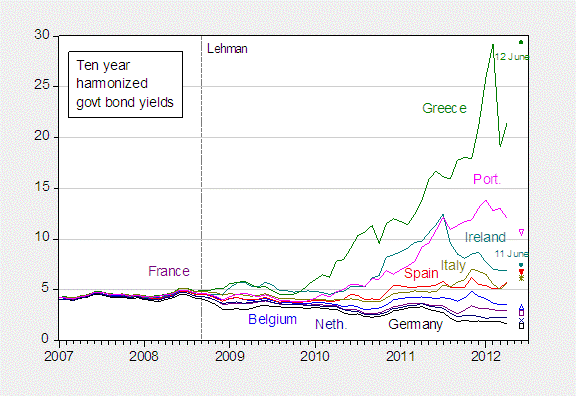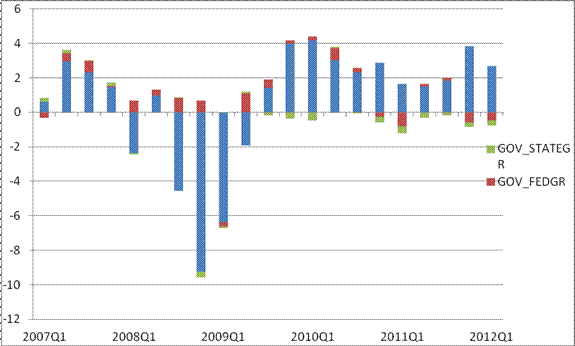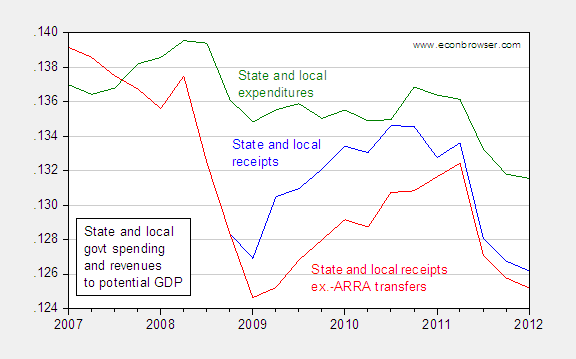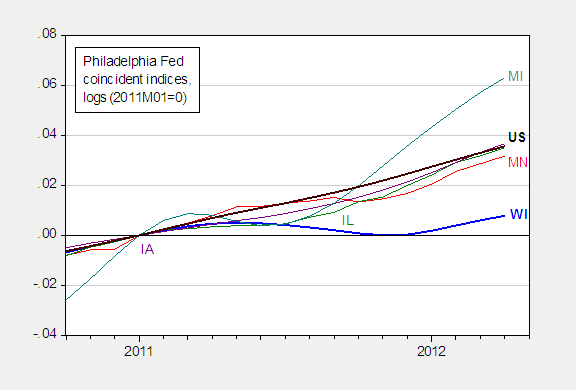The GIIPS countries on the periphery of Europe are undertaking fiscal retrenchment that is largely self-defeating, because they have little choice given the structure of the eurozone’s governance, and Germany’s policy position. The United States, in contrast, is undertaking reducing government spending not because it has to, but because of an ideology that sees austerity as a convenient means of bludgeoning the opponents of a reasoned fiscal policy.
Last week, I had the opportunity to participate in a panel on “Assessing the Austerity Experiment”, at the Center for American Progress. (The video of the proceedings is here). The panel included Carlos Mulas-Grenados, Jared Bernstein, and Zach Schiller, and was moderated by Michael Ettlinger, and took place at an opportune time; that morning France had been downgraded by Moody’s, and Italian yields had risen above Spanish yields (which were both above 7%).

Figure 1: Ten year harmonized government bond yields, and yields for June 12. Source: ECB, and FT for June.
It’s clear from this graph that the approach of muddling through, dealing on an ad hoc basis with each crisis with aid conditioned on fiscal consolidation, is not working. It’s not working partly because in the demand determined models we teach in intermediate macro work cutting government spending and raising taxes tends to depress output, as highlighted in this post. But when the countries affected are closely linked by trade, then the total effect of the contractionary policies conducted in individual countries results in even greater contraction. [1]
Had these economies been on floating exchange rates, the contractionary effects might have been mitigated by depreciated currencies. But membership in the eurozone meant that shock absorber was gone. That is why the prospect of an expansionary fiscal contraction was never very plausible in the case of the GIIPS. But as long as the rest of the eurozone countries were unwilling to provide substantially more financing or transfers to the GIIPS, these governments had little alternative to fiscal consolidation. That is the fate of many, many countries that have faced IMF stabilization packages in earlier decades.
In contrast, in the United States, the sovereign has easy access to financing. Benchmark yields are 1.5%, real interest rates at the ten year horizon are zero, according to TIPS. The dollar remains the pre-eminent reserve and international currency, and certainly promises to remain so in the near term, given the sovereign debt crises in the rest of the world. And yet, the next figure shows that government consumption spending is exerting a drag on GDP, at both the state and Federal levels.

Figure 2: Contributions to GDP growth, form state and local government (green) and from Federal government (red), and all else (blue), in percentage points. Source: BEA, 2012Q1 second release.
Now turn to the individual states; they have to run pretty much balanced budgets. But they could have run balanced budgets at relatively high levels of spending, or relatively low levels of spending.
In contrast to Europe, the choice to slash spending and taxes was unforced. In the absence of tax cuts, spending could have been maintained at higher levels. Furthermore, the Federal government had the resources to further support the state and local governments. According to the CEA, by June 2011, the ARRA had provided for $130.8 billion in transfers to the states. It’s clear from Figure 3 that this support helped maintain spending levels.

Figure 3: State and local receipts (blue), state and local receipts ex ARRA transfers (red), and state and local spending (green), all as a share of potential GDP. Source: BEA, 2012Q1 second release, CEA, and author’s calculations. Assumes 2011Q3-2012Q4 transfers at $4 billion per quarter.
Truly, much of the distress at the state and local level is essentially a self-inflicted wound, that allows a push for smaller government to proceed under the guise of austerity. Figure 4 presents comparative behavior of indicators of aggregate economic activity in the Midwest region.

Figure 4: Log coincident economic indices, normalized to 2011M01=0. Source: Philadelphia Fed, and author’s calculations.
Update 6:15pm: Note that Wisconsin, which has aggressively cut spending, has lagged far behind the nation, and Fed district neighbors, since 2011M01.
Here in Michigan, the economy is better, but on an absolute basis not necessarily good. Unemployment rates are declining as the automotive industry and related service industries recover from the 2008-10 economic “mariana trench” and the “forced austerity” that occurred has resulted in a much healthier fiscal situation. Generally, I’d say the outlook in Michigan, at least, is somewhat upbeat… but cautious.
Still, I’m not sure what your intent with figure 4 is. Michigan, like Wisconsin, has rebalanced the budget along a different pattern with some big cuts along the way and shifting of taxes to boot. Has Minnesota done the same? Why isn’t Illinois shown? Likewise, Indiana.
Is it time to reconsider GDP growth as the most critical economic metric? Consumption seems to be destroying humanity. We have peak oil, climate change, loss of arable land, huge shortages of potable water, and a world wide population bomb. The US consumes more per capita than any other country. Perhaps stimulating demand may be good for macroeconomic analysis, but bad for the world.
I am sensitive to the plight of the unemployed and underemployed. But, the cost of improving that plight as a public good seems to be an unaccounted for public harm. According to a PBS show (Attenborrough hosted) the world can sustainably support about 3 billion people. We now have about 7 billion on the planet.
Is there a different measure? Can economics help, or was Malthus correct?
It is said that ‘Austerity is self-defeating’.
It is said ‘There is room for fiscal/monetary expansion’. What happens after the fiscal/monetary expansion? More fiscal/monetary expansion?
If ten trillion dollars cannot produce ‘sustainable business activity’ how about twenty-trillion? Forty trillion? How about five-thousand billion-gazillion trillion duo-dollars? How about a fat man in an ill-fitting suit smoking a cigar, riding a horse backward?
When will folks understand that sustainable business activity is a myth like Catholic transubstantiation, leprechauns or flying elephants?
Q: Does driving your car earn money for you? How much did that car cost? How much did that war to ‘assure’ crude oil to burn in that car cost? How is all that paid for? By taking on debt?
When do we stop fooling ourselves?
The United States, is undertaking reducing government spending not because it has to, but because of an ideology that sees austerity as a convenient means of bludgeoning the opponents of a reasoned fiscal policy.
First, there should be no comma between the subject and verb in the initial clause.
And B), the United States (which presumably includes the budgets of those United States) is reducing government spending because of constitutional constraints at the state level, as well as for the reason stated in the quoted sentence.
We have used one of the major construction companies in our area to build three major building complexes for us over the past 5 years. In all three projects the company completed the work ahead of schedule and under budget.
The company is currently building a hospital for the VA. I just heard that the building is both behind schedule and over budget. The VA is talking about suing the company. The company says that the reason for the delays and cost over-runs is because the VA keeps changing their design.
Guess how many times we changed our design? We did due diligence up front and worked closely with the architect, the company and our own people to get the design right up front.
Is this an isolated situation? When I worked for another major company I was investigating an advanced computer system with optical readers. I asked the representatives for a ball-park number for the design. They said they would have to get back with me because the only installation they had made was at a government facility. I asked them to just give me that price as a ball-park. They said that when they do any construction for the government they always spend 30% to 40% more because of design changes. That my price would be significantly less. This was many years before the VA event above.
So the real question – is it valid to assume that all spending is equal whether private or public? For the analysis above to be valid don’t you have to make that assumption? How many are prepared to make this assumption?
Those of us who want smaller government do not want it for its own sake, that is the motivation of the larger government for “stimulus” advocates. We want smaller government so that we can have better services at lower cost.
Thanks for using the acronym ‘GIIPS’. I detest the usage of ‘PIIGS’, it’s demeaning and prejudicial.
Bruce Hall: I included states in the Fed district. IL is included (green) — read the legend to the table. Michigan is higher relative to 2011M01, but lower relative to last peak.
kharris: Thanks for catching the typo; a phrase was omitted, and is now included.
My point is at the state level, one can balance budgets by raising taxes and cutting spending. It is more contractionary to cut taxes (say, for corporations), raise taxes for households, and cut spending to compensate for the tax cuts. As in Wisconsin.
Truly, much of the distress at the state and local level is essentially a self-inflicted wound
well, I’m not sure about that. On a nominal basis state and local expenditures and tax receipts have gone up (even though as a percent of gdp they have gone down). A decline in employment and expenditure is in part due to holes in pension funding that the crash caused (i recall its about 620 Bn $$, compared to annual contributions of 125 Bn, and the most recent data i saw only 1/2 that closed). I am not convinced that those pension benefits and structural fiscal positions were sustainable. I realize cut backs during a recession should be avoided, but its not like we are getting much help from the Fed either.
Let’s be honest and not call actual profligacy austerity! These are the actual 2011 deficit to GDP numbers:
Greece – 9%;
Spain – 9%;
Portugal – 6%;
Ireland – 13;
Italy – 4%;
The problem is not the austerity which has never been part of these countries’ cultures, but the inability to ramp up spending and roll over debts in the face of lackluster demand for their public debt.
We have gone a long way from prison for debts (abolished in 1867 in France ,1869 in UK) to debts as a factor of productivity, to debts free and debts for free.
Baychev wrote: Something about Deficit to GDP numbers.
That couldn’t be because ratios have denominators, could it?
Irrespective of the macroeconomics, just from a public choice perspective and practical knowledge of the legislative process, if we don’t cut back government when times are lean, it will never get cut back.
So what Menzie regards as a bug is actually a feature.
In flush times, legislators have ever incentive to help their re-election chances by buying off every constituency possible with government largesse. It is only in lean times that the financial pain is such that this largesse is rolled back.
Does this exacerbate recessions? The question is irrelevant.
I am finding more and more liberals making the case that government should borrow when interest rates are low. As a personal matter, this is not the worst advice they could give. If you need a new car, now is a great time to buy it. But no one should look at low rates as a reason to go on an unnecessary spending spree, that would be risky to your personal finances. Ditto for the government.
Baychev figures may need a review
This link may assist
http://www.bolshoi.ru/en/
Menzi-
Why is it that you never talk about the Bank of International Settlements and coordinated international credit policy?
From my perspective, it looks like all western central banks are reigning in credit expansion precisely because existing credit pool can not be properly serviced. All the arm waving about counter-cyclical policy seems disingenuous in comparison to the debt monster that confronts us. Why aren’t you advocating that bad credit instruments be liquidated instead of being propped-up by institutional manipulation?
@ ppcm : “We have gone a long way from prison for debts (abolished in 1867 in France ,1869 in UK) to debts as a factor of productivity, to debts free and debts for free”.
Haha, thats a good one !
I have some debt for sale, is there anyone left without debt ?
In every country in the Eurozone except Ireland, even in countries who are increasing taxes and or cutting spending (“austerity”), deficits are shrinking faster than GDP is. In MOST cases GDP IS IN FACT GROWING DESPITE AUSTERITY. One of the worst cases, Greece, their deficit has shrunk 45% while the economy is essentially flat. That’s a win, not a loss.
AGAIN FOR CLARITY
EVEN IN COUNTRIES WITH SHRINKING GDP, DEFICITS ARE SHRINKING FASTER THAN GDP IS.
If Austerity continues, budgets will be balanced and growth will continue.
BY ANY OBJECTIVE MEASURE, austerity is working.